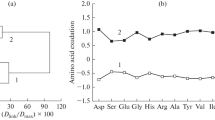Summary
Wheat and pea seedlings were grown aseptically in solution-culture and the total free amino nitrogen released by the roots was determined by a quantitative ninhydrin test. Amino nitrogen from wheat plants after 14 days growth was not detected by the test, indicating the release of less than 3 µg of amino nitrogen from a culture of 15 plants. Pea plants of the same age released from 2 to 7 µg per plant. Paper chromatograms of highly concentrated undisturbed solution-cultures revealed up to 13 amino compounds from wheat and 11 from pea. The pattern of amino acids in exudates was similar to that in crushed roots, except for an unidentified amino compound which was detected only in exuded material. The total amino nitrogen and relative proportions of several amino acids in the root exudates of sand-grown peas was influenced by several ratios of oxygen and carbon dioxide supplied to the root zone. Roots, experimentally damaged by swirling and rinsing in sand, released in 1 hour amino nitrogen of from 73 to 120 per cent of that released by ‘normal’ exudation over a 2-week period. Our findings suggest that experimental and environmental root damage may be responsible for a large proportion of organic materials released by growing plant roots.
Similar content being viewed by others
References
Boulter, D., Jeremy, J. J. and Wilding, M., Amino acids liberated into the culture medium by pea seedling roots. Plant and Soil24 121–127 (1966).
Buxton, E. W., Some effects of pea root exudates on physiologic races ofFusarium oxysporum f.pisi (Linf.) Snyder and Hansen. Trans. Brit. Mycol. Soc.40 145–154 (1957).
Clayton, M. F. and Lamberton, J. A., A study of root exudates by the fog-box technique. Australian J. Biol. Sci.17 855–866 (1964).
Hoagland, D. R. and Arnon, D. I., The water-culture method for growing plants without soil. California Agr. Expt. Sta. Circ.347, (1950).
Katznelson, H., Rouatt, J. W. and Payne, T. M. B., Liberation of amino acids by plant roots in relation to desiccation. Nature174 1110–1111 (1954).
Miller, R. H. and Schmidt, E. L., A technique for maintaining a sterile soil: plant root environment, and its application to the study of amino acids in the rhizosphere. Soil Sci.100 267–273 (1965).
Rosen, H., A modified ninhydrin colorimetric analysis for amino acids. Arch. Biochem.67 10–15 (1957).
Rovira, A. D., Plant root excretions in relation to the rhizosphere effect. I. The nature of root exudate from oats and peas. Plant and Soil7 178–194 (1956).
Rovira, A. D., Root excretions in relation to the rhizosphere effect. IV. Influence of plant species, age of plant, light, temperature, and calcium nutrition on exudation. Plant and Soil11 53–64 (1959).
Rovira, A. D., Plant root exudates and their influence upon soil microorganisms.In: Baker, K. F. and Snyder, W. F., Eds. Ecology of soil-borne plant pathogens, prelude to biological control. p. 170–184. University of California Press, Berkeley (1965).
Schroth, M. N. and Snyder, W. C., Effect of host exudates on chlamydospore germination of the bean root rot fungusFusarium solani f.phaseoli. Phytopathology51 389–393 (1961).
Smith, I., Chromatographic and Electrophoretic Techniques, Vol. I. Interscience Publishers, Inc., New York, (1960).
Stotzky, G., Culbreth, W. and Mish, L. B., Apparatus for growing plants with aseptic roots for collection of root exudates and CO2. Plant Physiol.37 332–341 (1962).
Thompson, J. F., Honda, S. I., Hunt, G. E., Krupa, R. M., Morris, C. J., Powell, L. E., Jr., Silberstein, O. O., Towers, G. H. N., and Zacharius, R. M., Partition chromatography and its use in the plant sciences. Botan. Rev.25 1–263 (1959).
Vančura, V., Root exudates of plants. I. Analysis of root exudates of barley and wheat in their initial phases of growth. Plant and Soil21 231–248 (1964).
Virtanen, A. I., Berg, A. M. and Kari, S., Formation of homoserine in germinating pea seeds. Acta. Chem. Scand.7 1423–1424 (1953).
Virtanen, A. I., von Hausen, S. and Laine, T., Investigations of the root nodule bacteria of leguminous plants. XIX. Influence of various factors of the excretion of nitrogenous compounds from the nodules. J. Agr. Sci. 27, 332–348.
Wright, D. E., Amino acid uptake by plant roots. Arch. Biochem. Biophys.97 174–180 (1962).
Author information
Authors and Affiliations
Additional information
Trade names are used in this publication to provide specific information. Their use does not constitute a guarantee of the products named and does not signify that they are approved by the U.S. Department of Agriculture to the exclusion of others of suitable composition.
Rights and permissions
About this article
Cite this article
Ayers, W.A., Thornton, R.H. Exudation of amino acids by intact and damaged roots of wheat and peas. Plant Soil 28, 193–207 (1968). https://doi.org/10.1007/BF01880238
Received:
Issue Date:
DOI: https://doi.org/10.1007/BF01880238



